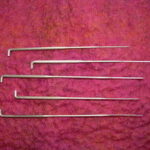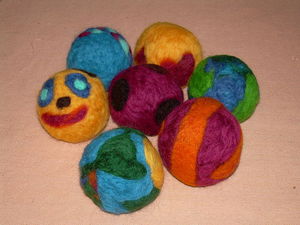A process called felting is used to create a tight weave in a crochet or knitted item. The texture of the item feels like a plush felt with fuzz. Felting has become very popular with avid crochet and knitting enthusiasts. The process is easy once the wool yarn project is finished. To felt a crochet or knitted project, it must be made from a 100 percent wool yarn that is not labeled ‘superwash.’ “Superwash’ on the label means the wool will not shrink when washed.
Any crochet or knitted item can be felted. There are no adaptations necessary to the pattern except changing the size of the crochet hook or needle. As a general rule of thumb, use a crochet hook or knitting needle three sizes larger than what is recommended for the pattern. The project will look very huge and this is what is necessary to achieve the felting. The large open weave is necessary to create a proper felted look.
The felting process works through the use of heat and agitation. A large loose crochet or knitted item is placed in hot water and allowed to shrink. The shrinkage is what causes the felting. Experiment with your first felting project by creating a sample block that is 6-inches long. Follow these easy felting instructions to create your first felted block.
Felting Process:
Step 1 – Set the dial on the washing machine to hot water and cold rinse if possible. If the double setting is not allowed on your washing machine, just set it to hot. Start the cycle.
Step 2 – Place the sample square in the hot water. Add 1 tablespoon of mild detergent and 1 quarter cup of plain salt. The detergent will help in the shrinking process while the plain salt sets the color in the yarn and prevents it from bleeding. When felting several pieces at one time, set the washing machine to a large load. Add one quarter cup mild detergent and 1 cup of plain salt. Allow the washing machine to agitate. Do not allow the washing machine to go into the spin cycle until the desired felting is achieved. If for some reason the spin cycle kicks in, turn the washing machine off, spin the dial to reset the washing cycle and restart.
Step 3 – Remove the block from the hot water approximately every 2 minutes to check for shrinkage. The entire felting process will take between 10 to 20 minutes. Note – The block will get larger before it starts to shrink. The swelling is caused by the yarn absorbing the water.
Step 4 – Turn the washer to the spin cycle when the block reaches the desired size.
Step 5 – Rinse the block with cool water. The cool water helps to stop the shrinking process. Make sure to squeeze out any excess water before moving to Step 6.
Step 6 – Place a thick towel on a flat work surface. Make sure the towel is in a location where it can stay until the felted piece is completely dry. Place the felted block on the thick towel. Shape the block by pulling it you’re your hands. Pin the edges in place with straight pins or quilting pins. Put it in a safe location to air dry.
Tips:
It is important to weave all loose ends securely in the crochet or knitted project prior to the felting process. Loose ends will cause holes in the finished item.
Place the completed project in a zippered pillowcase for easy retrieval from the washing machine. A kitchen tongs works well to grab the pillowcase rather than using your hands.
Light colored wool yarn is more difficult to felt than dark colors. This is due to the process in making the yarn.
Recycle old wool sweaters and create one-of-a-kind felted craft items.







